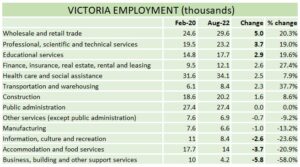Written by – Tony | WorkBC Labour Market Specialist
Employers in Victoria have experienced the same difficulty in filling certain types of open jobs that businesses in the rest of the country are having. Even though the number of international travelers in British Columbia has not fully rebounded, tourism operators on Southern Vancouver Island still had a very busy summer season. Many hotels, restaurants and tour companies in Victoria are experiencing pre-pandemic levels of business activity, but that doesn’t mean they are operating at full capacity. Staffing challenges have resulted in reduced hours of operation and lost business opportunities.
There are over one million job vacancies across the country with over 178,000 of those in British Columbia. B.C. is one of only two provinces with fewer unemployed people than there are open jobs. So what happened to all the workers? In the United States, there was a great resignation, but that trend did not take hold in Canada. What happened here is that we had a great reshuffling of our labour market with hundreds of thousands of workers in this country leaving lower-paying industries for higher-paying ones.
The first year and a half of the pandemic was marked by lockdowns and public health restrictions that greatly affected the restaurant, retail, and tourism sectors. When public health measures began to lift many employers in those industries were surprised to find that a significant amount of their workers were not returning to their jobs. Reduced immigration also impacted the pool of available workers. The data provided by Statics Canada allows us to see how all of this has impacted Victoria’s labour market.


In February of 2020, just before the pandemic began, there were just under 210,000 people working in Greater Victoria. As of August of this year that number has jumped to 216,400. Not only are there more people employed in the region – there is a higher percentage of the workforce employed on a full-time basis. Part-time employment has dropped, and full-time employment has soared.
As well as the shift towards full-time work there has been a change in what type of employment people have. Since the start of the pandemic, employment in Victoria has been up significantly in wholesale and retail trade (+5,000) jobs, professional, scientific, and technical services (+3,700 jobs) and educational services (+2,900 jobs). Sectors in the region that lost jobs over the same period include business, building and other support services (-5,700 jobs) and accommodation and food services (-3,700 jobs).
This shift in work can be partly explained by opportunity. Many sectors in Canada were not as affected by public health measures as others and continued to hire as normal, creating opportunities for those who had been laid off. Also, the rise of remote work offered some unemployed people the chance to seek employment that allowed for a better work/life balance or higher wages. The pandemic was an opportunity for many Canadians to assess their priorities and no doubt resulted in a career change for hundreds of thousands of people.
A recent CIBC poll showed that 17% of respondents have changed careers during the pandemic. The main reasons for that being to get a job with better wages or benefits, and a better work-life balance. What this means for local employers is that many of the employees they had before the pandemic have changed careers for good. Because of our aging population, labour shortages will be an ongoing theme in Victoria’s labour market – especially in the hospitality sector.
